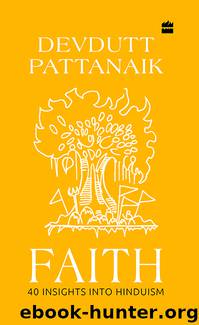Faith by Devdutt Pattanaik

Author:Devdutt Pattanaik
Language: eng
Format: epub
Tags: SOCIETY & CULTURE
Publisher: HarperCollins Publishers India
Published: 2019-05-09T16:00:00+00:00
21
Is the Hindu thread ceremony the same as the Christian baptism?
Baptism is a Christian ritual by which one declares their acceptance of Jesus Christ as the son of God, and humanity’s deliverer. In other words, baptism marks one’s admission into the Christian church; unless baptized, one cannot not be a Christian. Likewise, until a man undergoes circumcision, he cannot be Jewish, or Muslim. These are ritual declarations of one’s covenant, or agreement, with God. This idea of making a contract with God and becoming a member of the faith by a ritual is alien to Hinduism. One becomes Hindu by birth.
The thread ceremony is known by various names in different parts of India: Upanayanam in south India, Brata ghara ritual in Odisha, Janayu in Gujarat, Munja in Maharashtra and Karnataka, Poita in Bengal. But what is it? It depends on who you ask.
Historically, the thread ceremony is linked to Vedic Aryans. We find a similar ceremony among Parsis, who are an offshoot of the Indo-Iranian branch of Vedic Aryans. In an elaborate Navjote ceremony, the thread of seventy-two fibres (representing seventy-two chapters of the sacred text) is wrapped around the waist of the boy or girl three times and knotted in the front and the back. The untying and retying is done by the faithful to the chanting of prayers several times a day. Like a baptism, this ceremony, marks a person’s entry into the Zoroastrian faith which thrived in Iran (ancient Persia) before the rise of Islam. Though linked to Vedic roots, Zoroastrian faith is highly linear in structure (one life) in contrast to the Vedic faiths that are cyclical in structure (many lives).
In Vedic times, there was probably no thread. Instead a garment was worn over the left shoulder during household rituals and right shoulder during funeral rituals. Some Brahmins used deer skin as the upper garment and the spot where the head of the deer was located is today indicated by the Brahma-granthi knot. This is speculation, of course, but what scholars are confident of is that the ‘thread’ became a key part of the Hindu dress code in medieval and modern times, as the caste system became increasingly rigid and draconian.
In the dharma-shastras, there is reference to a sacred thread ceremony for men and women, and members of all varnas, not just Brahmins. In art, we find gods and goddesses sporting the sacred thread over their left shoulder. The thread is sometimes bejewelled, revealing they are all twice-born, with access to Vedic wisdom. However, by medieval times, this became a singular ritual to identify the Brahmin male, and locate him on top of the Hindu caste pyramid.
The ritual involves the placement of nine cotton fibres, twisted to make three threads, and knotted as one and worn over the left shoulder.
The nine individual fibres embody the sound Om, fire (Agni), serpent (Naga), moon (Soma), ancestors (pitr), the gods of birth (Prajapati), breath (Vayu), death (Yama) and the world (Vishwadeva). When bunched as three, they represent the three
Download
This site does not store any files on its server. We only index and link to content provided by other sites. Please contact the content providers to delete copyright contents if any and email us, we'll remove relevant links or contents immediately.
| Clergy | Devotionals |
| Faith | Inspirational |
| Meditations | Monasticism & Asceticism |
| Prayer | Prayerbooks |
| Ritual | Sermons |
More Language of Letting Go: 366 New Daily Meditations by Melody Beattie(2548)
The Holy Spirit by Billy Graham(2525)
To Light a Sacred Flame by Silver RavenWolf(2426)
The Secret Power of Speaking God's Word by Joyce Meyer(2342)
Tuesdays With Morrie by Mitch Albom(2252)
The Lost Art of Good Conversation by Sakyong Mipham(2189)
The Traveler's Gift by Andy Andrews(2093)
Kundalini by Gopi Krishna(1888)
A Kingsbury Collection by Karen Kingsbury(1774)
Finding Chika by Mitch Albom(1700)
Angels of God: The Bible, the Church and the Heavenly Hosts by Mike Aquilina(1676)
As a Man Thinketh by James Allen(1633)
Angels by Billy Graham(1609)
The Yoga of Jesus: Understanding the Hidden Teachings of the Gospels by Paramahansa Yogananda(1585)
Curse Tablets and Binding Spells from the Ancient World by Gager John G.;(1571)
Autobiography of a Yogi (Complete Edition) by Yogananda Paramahansa(1552)
Barking to the Choir by Gregory Boyle(1547)
Anxious for Nothing by Max Lucado(1479)
How To Be Born Again by Billy Graham(1467)
